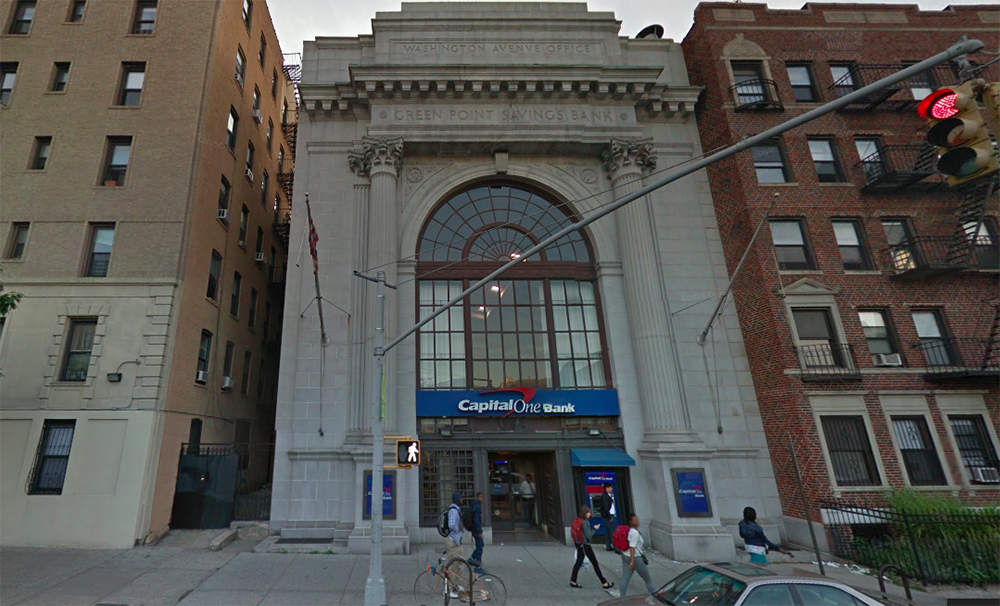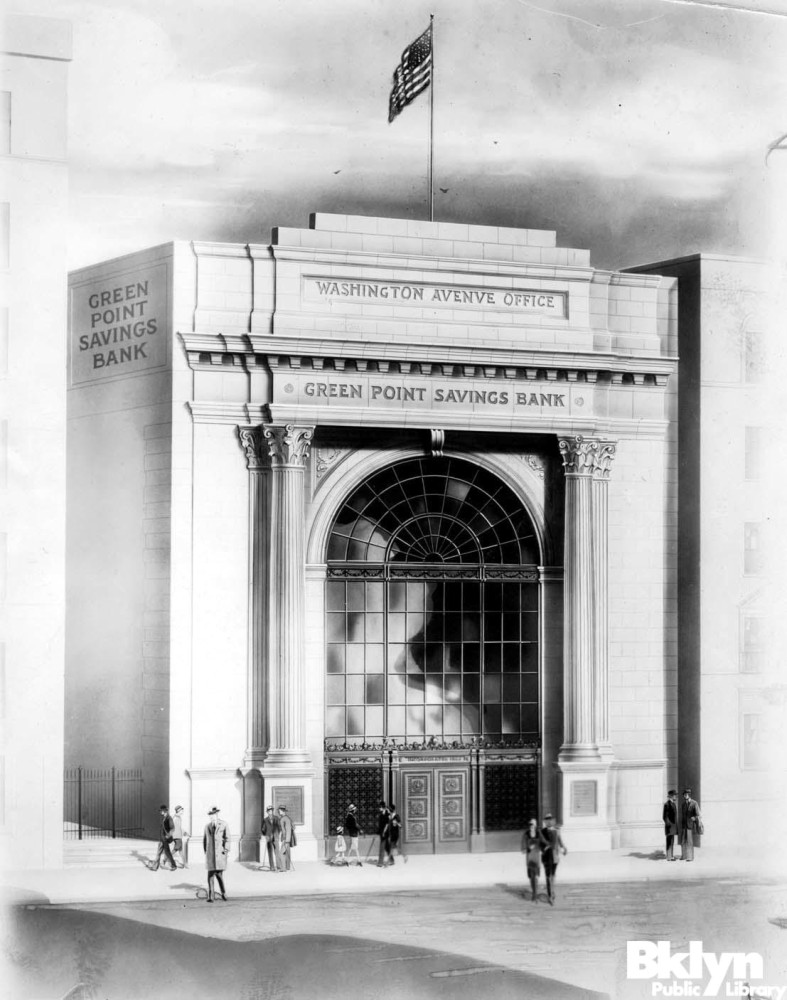A Look Back at the Prospect Heights Bank That Will Soon Be Razed for Condos
Brooklyn, one building at a time. An elegant bank built for a growing Prospect Heights community will soon be razed to make way for new condos. Here’s its story. Name: Former Green Point Savings Bank, recently Capital One Bank Address: 856 Washington Avenue Cross Streets: Eastern Parkway and Lincoln Place Neighborhood: Prospect Heights Year Built:…

Brooklyn, one building at a time.
An elegant bank built for a growing Prospect Heights community will soon be razed to make way for new condos. Here’s its story.
Name: Former Green Point Savings Bank, recently Capital One Bank
Address: 856 Washington Avenue
Cross Streets: Eastern Parkway and Lincoln Place
Neighborhood: Prospect Heights
Year Built: 1928
Architectural Style: Neoclassical
Architect: Francis George Hasselman
Other Works by Architect: Suburban residential architecture primarily in New Jersey, also North Carolina and other states
Landmarked: No, a tragic oversight
The intersection of Eastern Parkway and Washington Avenue sits at the base of the hill that rises to the top of Mount Prospect, the second-highest point in Brooklyn. It was a lookout point for George Washington during the Battle of Brooklyn.
For much of the 19th and half of the 20th century, Mount Prospect was home to the Mount Prospect Reservoir, where Brooklyn got much of its water. Today, it’s filled in and used as a city park.
The Brooklyn Institute of Arts and Sciences began building its magnificent new museum — now the Brooklyn Museum — only steps away, next to the reservoir, in the last years of the 19th century. It stood alone on Eastern Parkway, with little development across the street on the Prospect Heights side.
But by the end of the 1920s, large luxury apartment buildings lined Eastern Parkway and smaller apartment buildings were being built for the middle classes on Lincoln Place and the surrounding streets.
By 1928, this was a densely populated neighborhood, in need of services and amenities. It was a great place to put a bank.
The Green Point Savings Bank
The Green Point Savings Bank was established in Greenpoint in 1869, founded by local residents who wanted to open a mutual thrift organization. Savings banks were, and still are, made up of the pooled savings of the members. Historically, they were formed by many neighborhood or ethnic communities throughout the city. In addition to savings accounts, they were best known for issuing mortgages.
The Green Point (still two words) Savings Bank did very well, with more than $5 million in assets by 1905, and $12.5 million only six years later. It moved to a large, elegant, neoclassical bank building on Manhattan Avenue in 1908.
By 1928 they’d decided to branch out into other neighborhoods and chose this location for the new branch. The Brooklyn Eagle called the area the “Eastern Parkway Neighborhood.”
The new bank was designed by theManhattan architect Francis George Hasselman, known mainly for his work in wealthy New Jersey suburbs.
Hasselman did fine work with this neoclassic marble and limestone bank, designed to stand out here in the middle of the block.

Architect’s illustration via Brooklyn Public Library
The Washington Avenue Green Point Savings Bank Building
The bank’s most noticeable feature is the three-story arched window and entrance with a huge Palladian fanlight at the top of the arch. This feature is flanked by two impressive Corinthian columns and capitals. They support a large cornice with dentiled ornamentation.
The bank is reminiscent of Stanford White’s façade for the Bowery Savings Bank, built in 1895. This bank may not have been Hasselman’s usual style or medium, but he certainly learned from the masters.
The Brooklyn Eagle covered the bank’s opening on June 16, 1928. The reporter noted that the beautiful large window allowed in so much natural light that interior illumination during the day was unnecessary.
Customers used the front of the bank for transactions. There were 23 screens for tellers. A wall behind the tellers separated them from the safe-deposit boxes in the vault, offices and a small conference room.
An elevator in the rear took customers and staff to the president’s office and rooms where mortgages were closed. In the front of the bank, stairs led down to a ladies lounge.
The Eagle noted that the Green Point Savings Bank branch was not only the finest bank building in the neighborhood, but the only one. The bank stood out because of its unique status, its design, its placement on the street and because of the elevation — all reasons why it should have been landmarked years ago.
The Green Point SB continued to grow and the two words were officially condensed into one: Greenpoint. They opened other branches in Brooklyn and Long Island, including a branch in Flatbush that opened on the heels of this one.
Although the Great Depression destroyed many financial institutions, savings banks thrived because they did not speculate with their clients’ money. GPSB grew in assets and continued to issue mortgages throughout the remainder of the 20th century.
By 1983, they were making more mortgage loans than Citibank, even though the latter was 80 times as large.
In 2005, Greenpoint merged with North Fork Bank, and two years later North Fork merged with Capital One. The branch changed its signage but remained open. In 2014, Capital One moved to a new branch in a newly constructed building on Eastern Parkway and Bedford Avenue, two blocks away.
At this point there was speculation that it’d become a Trader Joe’s, but then in December 2014 the building was sold to Slate Property Group for $6.5 million. Earlier this month indications it was approved for demolition, and the developer plans to build a 14-story condo building on the site.
Neighborhood preservationists had long petitioned for the building, or at least its façade, to be saved, as it’s certainly worthy of landmark status. They haven’t given up yet, but it doesn’t look good.
[Top photo: Google Maps]
Related Stories
Prospect Heights Bank, Once Rumored to Be Trader Joe’s, Will Be Razed
Former Capital One Branch on Washington Avenue Sells for $6.5 Million
Walkabout:The Road to Prospect Heights









Why is no one on here asking the very simple question why LPC rejected this building and is not landmarking it. This is the elephant in the room. Once the building is landmark LPC can essentially grant waivers to make a building viable for residential conversion to modification of used in bulk. It’s a no brainer. But why is no one talking about it on here. Once again The LPC is failing.
Why won’t they keep and incorporate the beautiful facade? What a waste
The problems with reusing the facade are laid out here:
https://twitter.com/rachelholliday/status/653631857037344771
The zoning is restrictive. If a developer built on top of it, they wouldn’t be allowed to make the bank portion a commercial space. So it would have to be residential. But that means somehow making apartments that have only the enormous front window. Plus there is a height restriction, so a developer would be constrained by what they were able to build on top, which would make the project financially unfeasible.
Just saw this. Sounds like a regulative red tape that encourages developers to simply raze beautiful facades that are irreplaceable. The City should really look into cases like this and remedy their legal inefficiency. I don’t blame the developers.
That makes no sense, it’s the same as NY YIMBY pointed out is responsible for the lack of grocery stores in Clinton Hill…why are main avenues being designated as residential only? At least corner lots. But there’s no point in residential zoning for Washington and EP…that ship has long since sailed, it’s commercial.
This is good architecture. It is a shame that it will be replaced with something that I am sure cannot rival.
thank you for doing this! it’s very sad to see this one go. the first time i walked down lincoln place i saw this at the end of the street. it was a warm summer night and the facade was lit up beautifully. it’s been an incredible fixture over the years and i’m heart broken its going.
.
which is the bank in flatbush that opened soon after this one? does the building still stand?
Any pictures of the interior?
Nice catch, krb — I didn’t even realize since the quality makes it look like a totally different photo. Taking that out of there now.